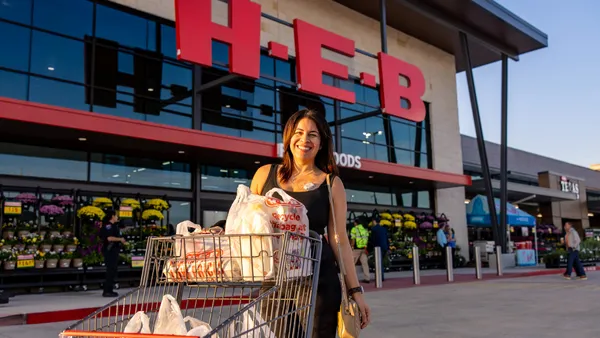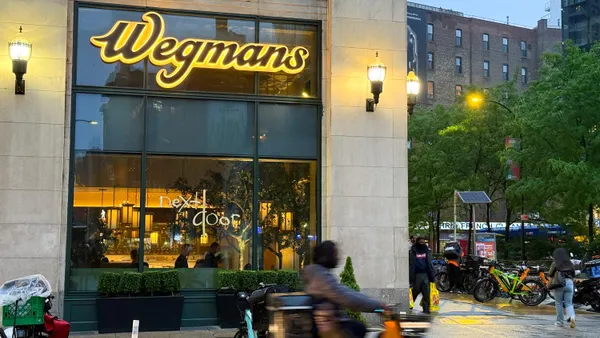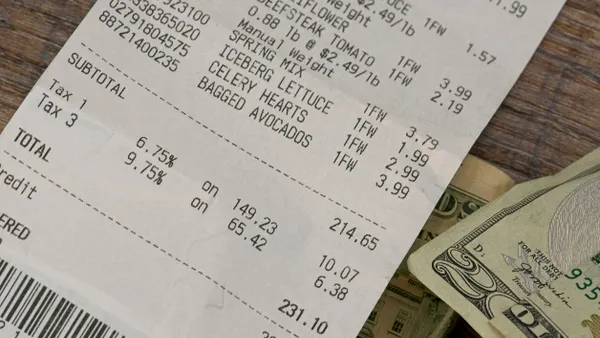Dive Brief:
- Whole Foods will shutter its 365 store format, which currently has 12 locations across the country, Yahoo Finance reported. The announcement came in an internal email sent to Whole Foods employees by founder and CEO John Mackey.
- In the letter, Mackey wrote that the lower-priced, low frills store format has become unnecessary due to Amazon’s ongoing price investments in Whole Foods stores. “As we have been consistently lowering prices in our core Whole Foods Market stores over the past year, the price distinction between the two brands has become less relevant,” Mackey noted. “As the company continues to focus on lowering prices over time, we believe that the price gap will further diminish.”
- The 12 existing 365 stores will remain open and corporate employees who had been working on the concept will be reassigned to other areas of the business, according to Yahoo Finance.
Dive Insight:
Prior to its acquisition by Amazon, Whole Foods had big plans for its 365 stores. And for a while there it seemed the format might survive under Amazon, with several stores opening since the tie-up, including two locations in Atlanta on the same day last month.
But 365 was the lifeline Whole Foods established for itself when it was struggling to turn a profit. Amazon has different plans.
Since it took over, the e-tailer has lowered prices across the brand and offered special discounts through its Prime membership program. The 365 phase-out indicates the retailer will keep chipping away at prices as it tries to knock down the stubborn “Whole Paycheck” title many shoppers still associate with the grocer. Reports issued in the months following the acquisition indicated that Amazon’s price cuts were more about marketing than actually lowering people’s grocery bills.
However, analysts have noted that Amazon has continued to make meaningful price investments in Whole Foods. Combined with its other plans in e-commerce and store build-outs, the move could really sharpen the grocers’ competitive offering.
“Our pricing surveys have shown that Whole Foods has indeed made and continues to make significant price investments,” Scott Mushkin, an analyst with Wolfe Research, wrote in a recent not to investors. “Taking the store growth ramp up together with the price cuts and the expanded Prime Now delivery from Whole Foods, we continue to see an increasing threat to the consumables industry from Amazon.”
Still, Amazon would do well to learn and even borrow from 365’s model, including its private label focused assortment and marketing that targeted younger consumers. Amazon has already made Whole Foods’ 365 Everyday brand a big part of its online push, and will likely do the same in stores to keep bringing prices down. 365 stores also featured innovative partnerships with local restaurants that could also work well in Whole Foods stores — particularly the larger locations that Amazon is reportedly eyeing.
Yahoo Finance reported the chain is looking to move into retail stores vacated by the likes of Sears and Kmart. This bucks the industry trend of smaller stores, but it could help Amazon establish Whole Foods locations as destinations, similar to Wegmans. In addition to dining spots, the larger stores could showcase Amazon technology and earmark space for e-commerce fulfillment.
How the retailer would balance large, splashy stores with its drive to lower prices and operational costs, however, is a big question.
Along with a broader pricing strategy, a desire for clarity seems to also be motivating Amazon’s decision to shutter 365. The retailer’s online grocery offerings are fractured and confusing right now, and it doesn’t want shoppers to have the same impression of its physical stores. Amazon Go appears to be Amazon’s attempt at smaller stores, with eight locations up and running and as many as 3,000 more potentially on the way.
Whole Foods, meanwhile, seems poised to claim more consumers as it evolves. But the grocer and its owner will need to keep pouring money into pricing and marketing as it goes along. A report issued last summer found store prices had fallen just 2% since the acquisition, while a Yahoo Finance survey of 2,000 consumers around the same time found that 40% believe prices haven’t shifted since Amazon acquired Whole Foods.










